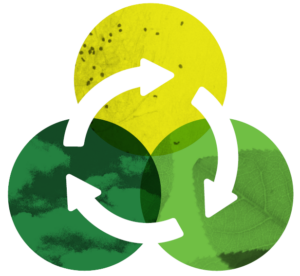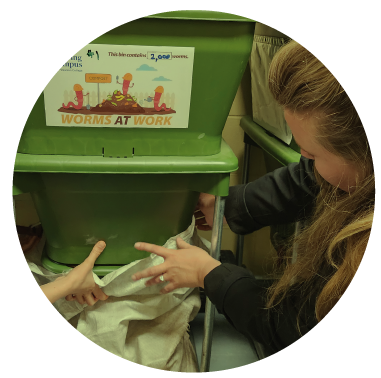Campus Living Labs: A Best Practices Guide for Canadian Colleges and Institutes
Discover how Canadian colleges and institutes are advancing climate action and reconciliation through Campus Living Labs.
This two-volume guide highlights a series of funded projects that turn campuses into vibrant hubs of sustainability and innovation. With insights and real-world examples from two cohorts, the reports are designed to inspire and provide you with valuable guidance to create successful sustainability projects on your own campus.
What is a Campus Living Lab?
 Through CICan’s ImpAct-Climate program, funded by the Government of Canada via the Environmental Damages Fund, our Campus Living Labs initiative invites members to turn their campuses into practical demonstration sites that integrate applied research and teaching with campus operations, culture, and infrastructure in ways that maximize sustainability. Each project aims to reduce greenhouse gas (GHG) emissions while increasing awareness and community engagement on emissions reduction, all while integrating Indigenous perspectives and approaches.
Through CICan’s ImpAct-Climate program, funded by the Government of Canada via the Environmental Damages Fund, our Campus Living Labs initiative invites members to turn their campuses into practical demonstration sites that integrate applied research and teaching with campus operations, culture, and infrastructure in ways that maximize sustainability. Each project aims to reduce greenhouse gas (GHG) emissions while increasing awareness and community engagement on emissions reduction, all while integrating Indigenous perspectives and approaches.
So far, 17 colleges and institutes have tackled diverse themes, including Indigenous knowledges and practices, food systems, waste management, transportation, and green building and land management. This broad thematic focus ensures each project aligns with local needs while addressing broader sustainability goals.
The Impact of Campus Living Labs
Campus Living Labs have proven invaluable as educational tools. They not only reduce GHG emissions but also provide opportunities for experiential learning, generating over 3.3 million awareness-raising interactions through workshops, online events, social media, and outreach on campus and in local communities. These projects serve as a bridge from climate awareness to action, inspiring both individual and collective behaviour change.
To date, projects have reduced campus GHG emissions by at least 34 mt CO2e,and with carbon sequestration, the number reaches a minimum of 1,054 mt CO2e. This is the equivalent to removing over 191 cars from the road for a year or planting 84,320 six-year-old trees! These figures reflect reductions measured within the active project periods, with ongoing impacts likely adding to these totals as projects continue.
Key Takeaways from the Reports
Campus Living Labs projects reveal that successful sustainability initiatives:
- Foster institutional change by promoting new approaches to environmental stewardship and engaging campus-wide support.
- Benefit from Indigenous perspectives, creating more inclusive solutions and strengthening connections with community and nature.
- Embrace circularity principles, maximizing resource use while integrating diverse sustainability themes for a broader social and environmental impact.
The report delves deeper into these lessons learned, covering how and why to build networks, invest in data, and overcome real-world challenges. For more comprehensive insights and practical examples, see the full report.
Campus Living Labs in Action
Volume II showcases 10 projects that exemplify how campuses can integrate teaching, applied research, and climate action through Campus Living Labs. Here is just one example:
Dawson College: Vermicomposting for Circular Sustainability
 Dawson College’s Campus Living Lab tackles waste reduction and food systems through a vermicomposting project. This initiative engages students in each stage of composting, transforming cafeteria food waste into nutrient-rich compost for rooftop gardens and a native plant nursery, supporting Indigenizing efforts by “bringing nature back onto the campus”. The compost supports urban and local agriculture, producing vegetables for sale at the Dawson market and for donations to those experiencing homelessness. The project also aligns with environmental science and agriculture courses, teaching resource management and waste minimization through circular economy principles in real-world contexts. Ultimately, it connects people, community, and nature through a sustainable, nature-based solution.
Dawson College’s Campus Living Lab tackles waste reduction and food systems through a vermicomposting project. This initiative engages students in each stage of composting, transforming cafeteria food waste into nutrient-rich compost for rooftop gardens and a native plant nursery, supporting Indigenizing efforts by “bringing nature back onto the campus”. The compost supports urban and local agriculture, producing vegetables for sale at the Dawson market and for donations to those experiencing homelessness. The project also aligns with environmental science and agriculture courses, teaching resource management and waste minimization through circular economy principles in real-world contexts. Ultimately, it connects people, community, and nature through a sustainable, nature-based solution.
Ready to learn more?
Volume II builds on the foundation established in the first volume, published in September 2023, by highlighting the accomplishments of our second cohort and further expanding on project best practices with new lessons learned. Stay tuned for the third and final report in Fall 2025, which will capture the full impact of this initiative.
Interested in More Case Studies?
Volume I offers 10 additional case studies from the first cohort of Campus Living Labs projects, each exploring unique sustainability solutions.

